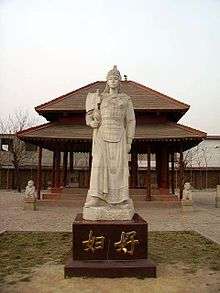Fu Hao
| Fu Hao | |
|---|---|
 Statue of Fu Hao at Yinxu | |
| Spouse | King Wu Ding |
| Issue | Prince Jie |
Fu Hao (simplified Chinese: 妇好; traditional Chinese: 婦好; pinyin: Fù Hǎo; died c. 1200 BC) or Lady Hao, posthumously Mu Xin (母辛), and sometimes Lady Fu Hao, was one of the many wives of King Wu Ding of the Shang dynasty and, unusually for that time, also served as a military general and high priestess.[1]
Her tomb was unearthed at Yinxu, by archaeologist Zheng Zhenxiang[2][3] intact with treasures such as bronzes and jades. Inside the pit was evidence of a wooden chamber 5 meters long, 3.5 m wide and 1.3 m high containing a lacquered wooden coffin that has since completely disintegrated.[4]
Biography
What is known is that King Wu Ding would cultivate the allegiance of neighbouring tribes by marrying one woman from each of them. Fu Hao (who was one of the king's 60 wives) entered the royal household through such a marriage and took advantage of the semi-matriarchal slave society to rise through the ranks.[5] Fu Hao is known to modern scholars mainly from inscriptions on Shang dynasty oracle bone artifacts unearthed at Yinxu.[6]
In these inscriptions she is shown to have led numerous military campaigns. The Tu-Fang had fought against the Shang for generations until they were finally defeated by Fu Hao in a single decisive battle. Further campaigns against the neighbouring Yi, Qiang and Ba followed; the latter is particularly remembered as the earliest recorded large-scale ambush in Chinese history. With up to 13,000 soldiers and important generals Zhi and Hou Gao serving under her, she was the most powerful Shang general of her time.[7] This highly unusual status is confirmed by the many weapons, including great battle-axes, unearthed from her tomb.[4]
Although the Shang King exercised ultimate control over ritual matters, which were the most important political activity of the day, oracle bone inscriptions show that Wu Ding repeatedly instructed Fu Hao to conduct special rituals and offer sacrifices. This was very unusual for a woman of that time, and shows that the king must have had great confidence in his wife. The sacrificial bronze vessels and tortoise shells inscribed prepared by Fu Hao discovered in her tomb further evidence her status as high priestess and oracle caster.[4]
She also controlled her own fiefdom on the borders of the empire, and was the mother of Prince Jie (oracle bone inscriptions show concern for her well-being at the time of the birth). She died before King Wu Ding, and he constructed a tomb for her on the edge of the royal cemetery at his capital Yin. The King later made many sacrifices here in hope for her spiritual assistance in defeating the attacking Gong, who threatened to completely wipe out the Shang.[5] The tomb was unearthed by archaeologists in 1976 and is now open to the public.
See also
References
- ↑ Ebrey, Patricia (2006). The Cambridge Illustrated History of China. Cambridge University Press. pp. 26–27. ISBN 0-521-43519-6.
- ↑ Loewe & Shaughnessy 1999, pp. 194-196.
- ↑ "The First Lady of Chinese Archaeology". TrowelBlazers. Retrieved 18 October 2015.
- 1 2 3 Buckley Ebrey, Patricia. "Shang Tomb of Fu Hao". A Visual Sourcebook of Chinese Civilization. University of Washington. Retrieved August 4, 2007.
- 1 2 "Woman General Fu Hao". All China Women's Federation. Archived from the original on February 14, 2007. Retrieved August 4, 2007.
- ↑ "The Tomb of Lady Fu Hao" (PDF). British Museum. Retrieved August 4, 2007.
- ↑ "Fu Hao – Queen and top general of King Wuding of Shang". Color Q World. Retrieved August 4, 2007.
Sources
- Loewe, Michael; Shaughnessy, Edward L. (13 March 1999). The Cambridge History of Ancient China: From the Origins of Civilization to 221 BC. London: Cambridge University Press. ISBN 978-0-521-47030-8.